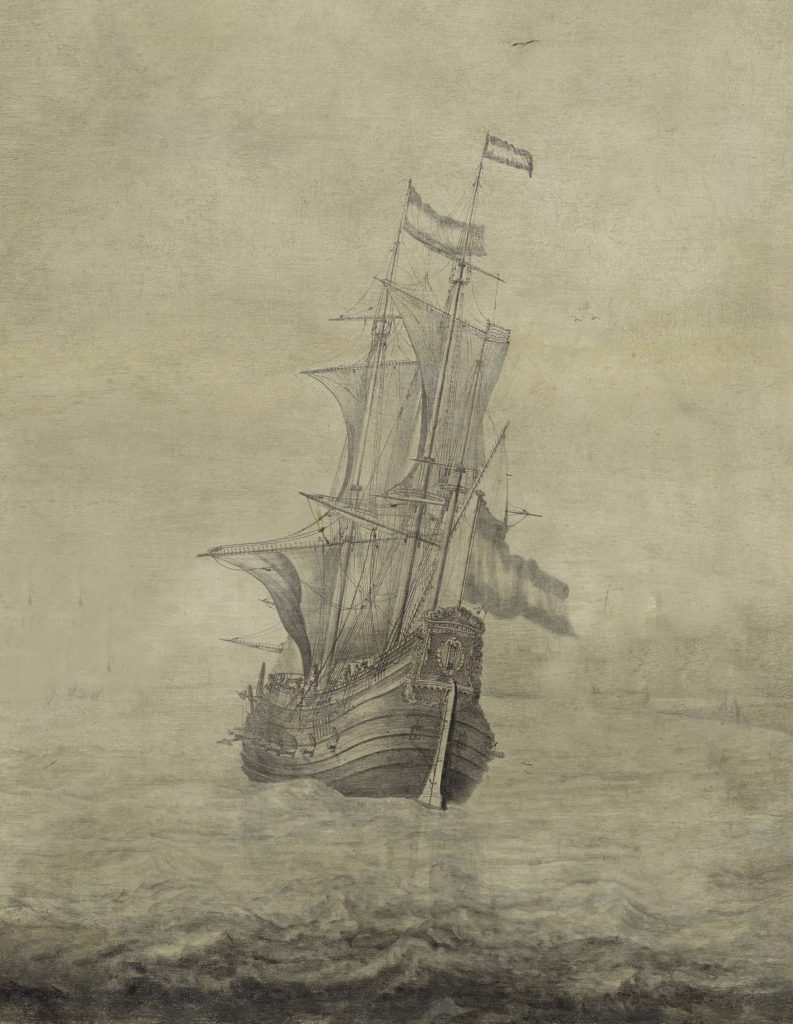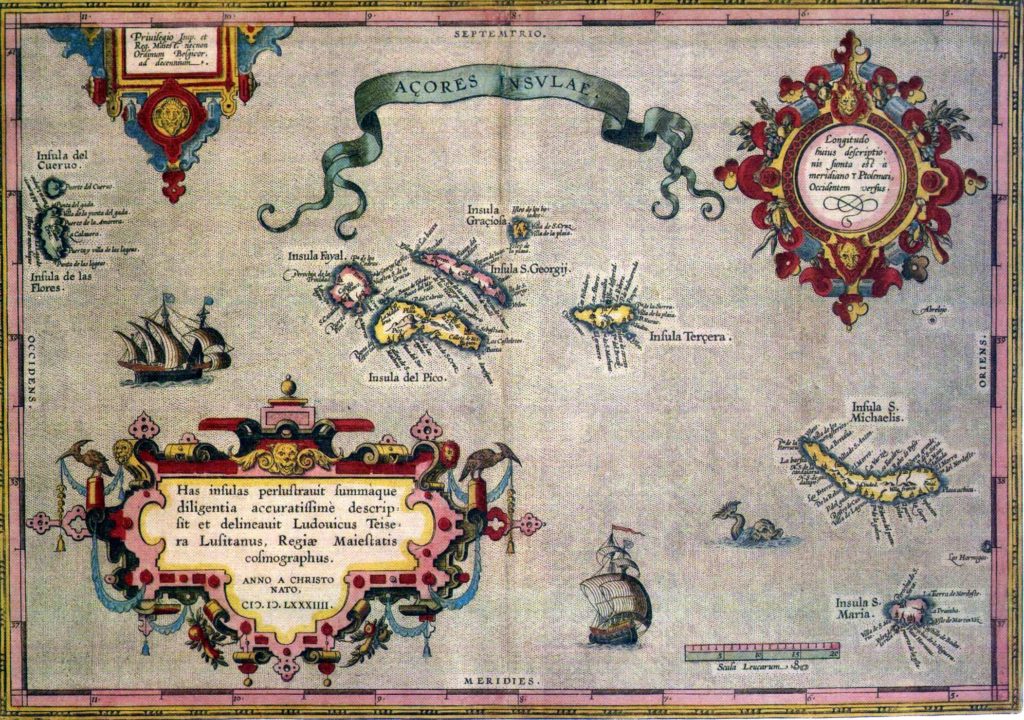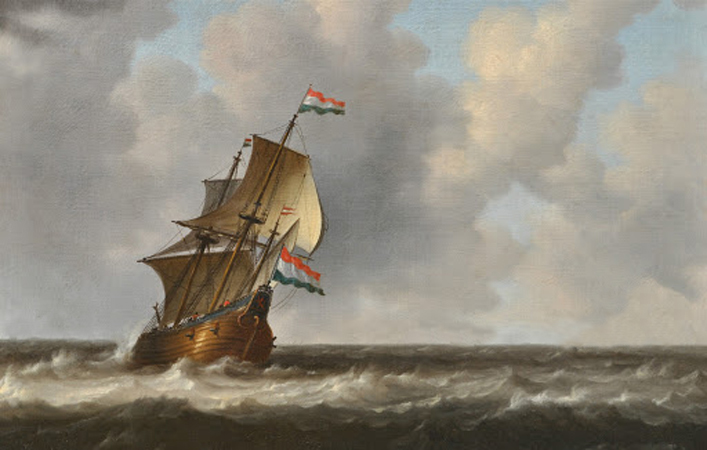(This post is a continuation of The Odyssey of René du Chastelet des Boys – Parts 1 through 9. If you haven’t done so already, it’s probably best to read those posts before continuing on here.)
The last episode ended, remember, with the lookouts of the corsair ship René du Chastelet des Boys was aboard having spotted a Dutch fluyt—a Dutch merchant ship—which they were about to chase.
Joseph Raïs, our Captain, called upon Dominque, the oldest of the captives we had taken near the Canary Islands, to know his thoughts on the discovery of this Dutch ship we had spotted. He learned nothing much other than the fact that Dominque had a general distrust of vessels from the Netherlands and that he could not tell if this ship was one of the ones the Canary Islands brigantines were hunting. This doubtful information left Joseph Raïs unsure for a considerable time, for he did not know if the fluyt we were chasing might be filled with men and artillery, and might already have defended herself well against the two brigantines. If that were the case, there was little to expect now but an exchange of unwelcome and destructive cannon fire.

His irresolution diminished, though, when the fluyt raised its sails and changed course to flee. Never did a hunting hound leap more quickly after a hare than Joseph Raïs’s ship did after the fugitive fluyt. After a chase, the Dutch ship was forced to either surrender or to fight. Those aboard chose the latter, but it was not a very spirited defense. There were, apparently, few among them who were willing to risk their lives, for rather than chance being consumed by worms or devoured by fish, they eschewed the liquid tomb that desperate maritime defense provides and chose instead to accept bondage in return for staying alive.
After three volleys of cannon fire, to which they replied with but a single shot, they raised a white flag… and the dropping of the sails and the movement of handkerchiefs denoted the surrender of the miserable flute. They then put their ship’s boat in the water and rowed over to receive the orders of Joseph Raïs, who, at the same time, dispatched fifteen of his men to board the fluyt. The Ouda Bachi, my master, was the leader of this group, and I went along with him and his soldiers. We all clambered aboard pell-mell.
The fluyt was carrying a cargo of woad [a plant used to make blue dye] and cedar wood. It was in the employ of merchants from Antwerp who had armed and equipped the ship in Lubeck [in northern Germany]. From there, it had sailed to Terceira [in the Azores], and was on the return leg when it had the unhappy luck to meet with Joseph Raïs and his corsairs.
The Azores were named for the birds which the Portuguese saw when they first discovered the island, for in their language such birds are referred to as Açores. The colonies of these birds were once so numerous that people could walk throughout the islands and be shaded by their countless wings. Now, however they have been all but exterminated by the settlements of the Portuguese.

This I learned from one of the merchants from Lubeck who was aboard the flute taken by Joseph Raïs. Once the Ouda Bachi, my master, had taken full control of the fluyt, he gave me access to interview the captives from the ship. After the first pains of their lost freedom were lessened, I learned more details from them about the Azores. There are nine islands: Terceira, São Miguel, Santa Maria, São Jorge, Graciosa, Faial, and Pico, all under a single government. Corvo and Flores are not included under the name of Azores, and yet they recognize the governor.
Angra, the capital of the Terceira, where the unfortunate fluyt had docked, is the main port. It is situated on a bay and protected by a mole that creates the harbor. Two watch towers, placed atop Mount Brazil, which appears detached and separated from the island, are perpetually manned by sentries who keep track of the approach and the number of ships from the west and the south. They sound trumpets and wave flags when they spot ships coming from the West Indies, the Guinea coast, Cap Vert [in Senegal], and also from Portugal and other places in the East and North.
Since slaves share the same common miseries, whether old slaves like me or new ones like those taken from the fluyt, the Ouda Bachi, my master, ordered me to find out everything I could about these new captives of Joseph Raïs. I did what I could to fulfill my slave duty, but yet tried to do so without prejudicing Christian charity, and also without prejudicing the interests of the new captives. Accordingly, I assured the Ouda Bachi that the fluyt’s crew all had no expectation of ever being ransomed and had no other home than their floating wooden house, out of which they had now been were driven in perpetuity. The Ouda Bachi put faith in my report and so left the captives alone during the rest of our journey.
Joseph Raïs, happy with the booty he had taken, gave orders to return to Algiers. We had good following winds and soon entered the Strait of Gibraltar, through which we passed without any encounters other than with several small fishing boats which immediately fled back to their ports upon seeing us. The favorable wind continued, and although this channel that separates Europe from Africa is usually infested with galleys and warships, we sailed thought it without misadventure. At one point, we gave chase to two brigantines from Malaga that we spotted, but they retreated from us in good order and without fear.
When we reached Algiers, Joseph Raïs omitted nothing that could contribute to his triumphant entry: the waving flags of the captured fluyt, the banners, the strident music of trumpets, the firing of the artillery on board… all announced to his friends, and any others waiting interestedly on the shore, the importance of his catch—which consisted of woad, cedar, sugar, and Spanish reales [pieces of eight].
After the ordinary ceremonies, the booty was brought and deposited in some stores near the harbor, except for the Spanish reales, which were loaded upon the shoulders of a few Moors and carried in a procession along with Joseph Raïs and the new captives. I followed this procession to the courtyard of the Pasha’s [the Ottoman Governor’s] palace, where we were commanded to remain until his return. The Pasha, alerted by the noise and commotion, soon appeared. The Ouda Bachi went in to see the Pasha, along with Joseph Raïs’ but ordered me to stay behind and determine the faculties, countries, and ages of the captives they were bringing to the Pasha.
Once the ceremony was over, they all came back, apparently fully satisfied. Joseph Raïs returned to his home, and the Ouda Bachi returned to the janissary barracks, followed by me.
____________________
For the next installment of René du Chastelet des Boys’ adventures, see The Odyssey of René du Chastelet des Boys – Part 9.
For those who may be interested…
The above excerpt (which has been slightly abridged) comes from des Boys’ L’Odyssée ou diversité d’aventures, rencontres et voyages en Europe, Asie et Affrique, pp. 68 – 72.

Corsairs and Captives
Narratives from the Age of the Barbary Pirates
View Amazon listing
The Travels of Reverend Ólafur Egilsson
The story of the Barbary corsair raid on Iceland in 1627
View Amazon listing